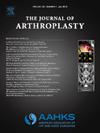接受全关节关节置换术的阻塞性睡眠呼吸暂停患者术后并发症风险增加:系统回顾与元分析》。
IF 3.4
2区 医学
Q1 ORTHOPEDICS
引用次数: 0
摘要
背景:阻塞性睡眠呼吸暂停(OSA阻塞性睡眠呼吸暂停(OSA)与多种不良健康后果和术后并发症有关。尽管OSA在接受全关节成形术(TJA)的患者中发病率很高,但很少有研究对OSA患者在接受关节成形术后的术后情况进行评估:方法:使用 PubMed(MEDLINE)和 Scopus(EMBASE、MEDLINE、COMPENDEX)对从开始到 2023 年 7 月的文章进行系统性回顾。纳入了对患有和未患有 OSA 的 TJA 患者术后结果进行比较的主要研究。提取了术后医疗并发症、重症监护使用率、住院时间和死亡率数据。采用描述性统计和随机效应荟萃分析模型对现有数据进行分析。采用 "非随机干预研究中的偏倚风险 "对纳入的研究进行了方法学偏倚风险评估。本综述已在系统综述国际前瞻性注册中心注册(ID:CRD42023447610)。 结果:共纳入七项研究,患者总数为 20977 人(9425 名髋关节患者;11137 名膝关节患者;415 名髋关节或膝关节患者)。研究中最常见的是肺部并发症,其次是血栓栓塞事件。各研究还报告了心脏、胃肠道、血液学、泌尿生殖系统和谵妄事件。Meta 分析显示,OSA 患者发生总体医疗并发症的几率增加了 4 倍(OR [odds ratio], 4.23; 95% CI [confidence interval], 2.97 to 6.04; P < 0.001; I2 = 0%),发生肺部并发症的几率增加了 4 倍(OR, 4.31;95% CI,2.82 至 6.60;P <0.001;I2 = 0%),血栓栓塞并发症几率增加 2 倍(OR,1.92;95% CI,1.22 至 3.03;P =0.005;I2 = 9%),谵妄几率增加 4 倍(OR,3.94;95% CI,1.72 至 9.04;P =0.001;I2 = 0%):结论:OSA与总体医疗、肺部和血栓栓塞并发症之间存在明显关联。这些患者术后谵妄的发生率也较高。本研究结果表明,对于选择接受TJA手术的OSA患者,需要采取全面的围手术期策略来降低这些风险。本文章由计算机程序翻译,如有差异,请以英文原文为准。
Increased Risk of Postoperative Complications in Patients Who Have Obstructive Sleep Apnea Undergoing Total Joint Arthroplasty: A Systematic Review and Meta-Analysis
Background
Obstructive sleep apnea (OSA) has been linked to multiple adverse health outcomes and postoperative complications. Despite the high prevalence of OSA in patients undergoing total joint arthroplasty (TJA), few studies have evaluated the postoperative course of OSA patients after joint arthroplasty surgery.
Methods
PubMed (MEDLINE) and Scopus (EMBASE, MEDLINE, and COMPENDEX) were used to conduct a systematic review of articles from inception to July 2023. Primary studies comparing postoperative outcomes following TJA between patients who had and did not have OSA were included. Postoperative medical complications, utilization of critical care, hospital stay, and mortality data were extracted. Descriptive statistics and random-effects meta-analysis models were used to analyze the available data. Included studies were evaluated for methodological risks of bias using the risk of bias in non-randomized studies of interventions. This review was registered on the International Prospective Register of Systematic Reviews (ID: CRD42023447610).
Results
There were 7 studies with a total of 20,977 patients (9,425 hip; 11,137 knee; 415 hip or knee) that were included. Pulmonary complications were most frequently studied, followed by thromboembolic events. Cardiac, gastrointestinal, hematologic, genitourinary, and delirium events were also reported across studies. Meta-analysis revealed that OSA patients had 4-fold increased odds of overall medical complications (OR [odds ratio], 4.23; 95% confidence interval (CI), 2.97 to 6.04; P < .001; I2 = 0%), 4-fold increased odds of pulmonary complications (OR, 4.31; 95% CI, 2.82 to 6.60; P < .001; I2 = 0%), 2-fold increased odds of thromboembolic complications (OR, 1.92; 95% CI, 1.22 to 3.03; P = .005; I2 = 9%), and 4-fold increased odds of delirium (OR, 3.94; 95% CI, 1.72 to 9.04; P = .001; I2 = 0%).
Conclusions
A significant association was found between OSA and overall medical, pulmonary, and thromboembolic complications. These patients also had a higher incidence of postoperative delirium. The present findings underscore the need for comprehensive perioperative strategies to mitigate these risks in OSA patients who elect to undergo TJA.
求助全文
通过发布文献求助,成功后即可免费获取论文全文。
去求助
来源期刊

Journal of Arthroplasty
医学-整形外科
CiteScore
7.00
自引率
20.00%
发文量
734
审稿时长
48 days
期刊介绍:
The Journal of Arthroplasty brings together the clinical and scientific foundations for joint replacement. This peer-reviewed journal publishes original research and manuscripts of the highest quality from all areas relating to joint replacement or the treatment of its complications, including those dealing with clinical series and experience, prosthetic design, biomechanics, biomaterials, metallurgy, biologic response to arthroplasty materials in vivo and in vitro.
 求助内容:
求助内容: 应助结果提醒方式:
应助结果提醒方式:


